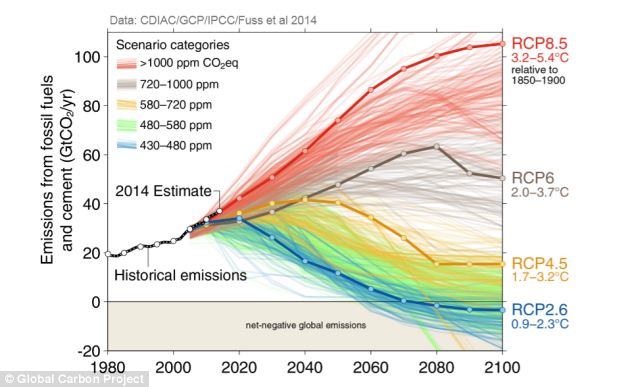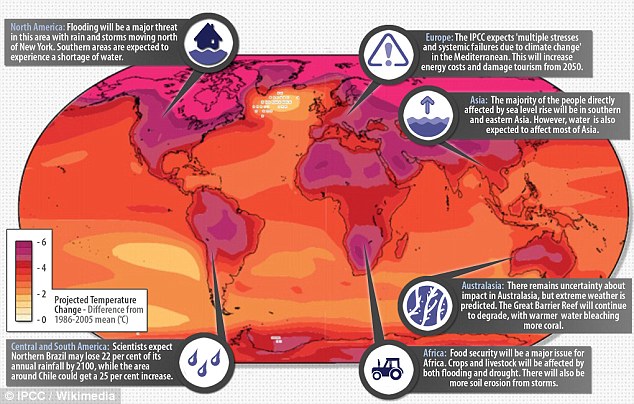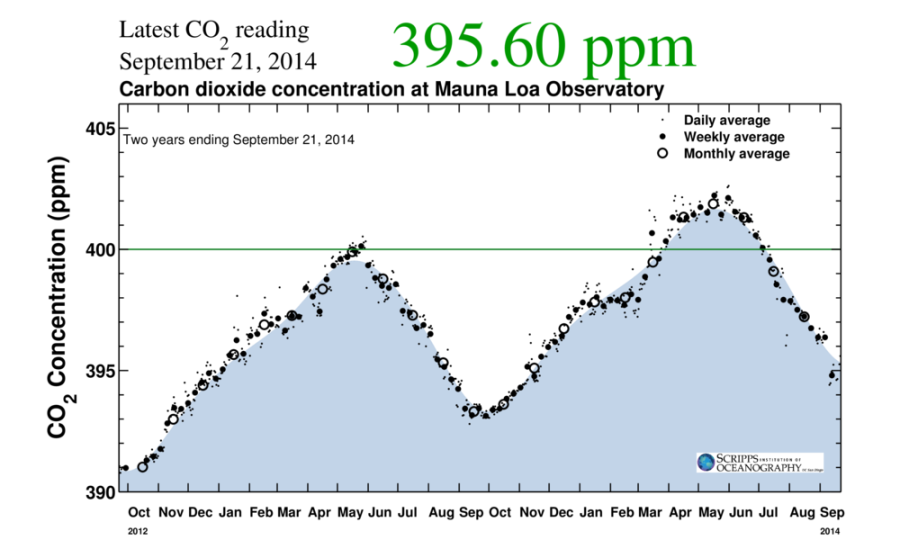A new report from the Global Carbon Project shows the world’s machines are belching more carbon dioxide than ever before. The report, which measures global CO2 emissions, found that gases from all sources jumped by more than 750 million tons during 2013 — a 2.3 percent increase in the dangerous hothouse gas over already extreme 2012 emission levels.
In total, 39.8 billion tons of CO2 hit the atmosphere in 2013, up from about 39.1 billion tons in 2012.
(Global carbon emissions continued along a worst-case track during 2013. Note that estimated temperature increases are for this century only. For context, it took 12,000 years for the world to warm 5 degrees Celsius at the end of the last ice age. Image source:
Global Carbon Project.)
On the current track, global CO2 emissions will double in about 30 years. This pace of emissions increase is along the worst-case path projected by the UN’s IPCC. One that will hit 8.5 watts per meter squared of additional warming at the top of the Earth’s atmosphere and greater than 1,000 ppm CO2 equivalent greenhouse gas heat forcing by the end of this century.
Such a massive increase from human sources does not include amplifying feedback emissions from global methane or CO2 stores such as those now apparently destabilizing in the Arctic. Such emissions could add an additional 20 to 30 percent or greater heat forcing on top of the human forcing, according to scientific estimates, by the end of this century.
The massive blow would be more than enough to trigger a hothouse extinction event — one that could well rival or exceed the Permian (also known as ‘the great dying’) in its ferocity due to the very rapid pace of the human heat accumulation.
(IPCC impacts graphic taking into account the RCP 8.5 scenario. Image source: IPCC.)
Overall, the pace of emission increase was slightly slower than during 2012, which showed a 2.5% increase over 2011. The lag was due, in part, to slowing economic growth in coal-reliant China. The massive emitter has lately shown trends toward lowering its carbon out-gassing as it half-heartedly pushes for cleaner air and less coal use. The US, on the other hand, showed a jump in carbon emissions as a trend toward greater natural gas usage whip-lashed back toward coal due to higher natural gas prices.
Greater adoption of renewable energy has slowed global carbon emission from absolute worst case levels. However, the pace of renewable adoption and increasing energy efficiency is not yet enough to knock the world off the horrific RCP 8.5 track. Such a switch would require a much stronger commitment from India and China together with an ever more rapid pace of transition away from fossil fuels for the developed world. To this point, both India and China have ominously opted out of a global climate summit to be held at the UN tomorrow. There, 120 global leaders will push for ways to rapidly reduce carbon emissions. But without buy-in from India and China, such measures may well be overwhelmed by increasing emissions from these very large and increasingly heavily mechanized Asian economies.
(Global CO2 concentrations as measured at the Mauna Loa Observatory. Image source:
The Keeling Curve.)
Meanwhile, global CO2 levels were hovering near their annual minimum at just above 395 parts per million after hitting a maximum level near 402 parts per million in May of 2014. At current rates of increase, global CO2 is likely to remain above the 400 parts per million concentration year-round within less than three years.
For context, the last time CO2 levels were this high, global temperatures were 2-3 degrees Celsius hotter than they were today and sea levels were at least 75 feet higher. But since humans emit a number of other powerful greenhouse gasses, the global CO2 measure alone doesn’t take into account the entire picture. If all other human heat trapping gasses are added in, the global CO2 equivalent heat forcing (CO2e) is around 481 ppm, which is enough to increase temperatures, long-term by about 3.8 degrees Celsius and to melt more than half of the world’s current ice sheets.
At the current pace of emission it will take less than 30 years to lock in a 550 ppm CO2 equivalent value — enough to melt all the ice on Earth and to raise temperatures by between 5 and 6 degrees Celsius long-term.
As such, the need for rapid transition to renewables together with reduction in harmful consumption could hardly be more urgent. With ever more harmful impacts being locked in with each passing year, the world needed strong global climate policy action yesterday. But action today will be better than waiting another decade or more as the situation continues to worsen.
Links:




0 Comments:
Post a Comment
Subscribe to Post Comments [Atom]
<< Home